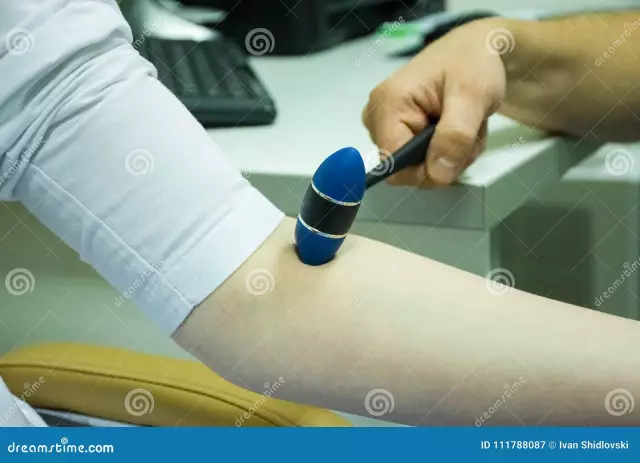- Author Curtis Blomfield [email protected].
- Public 2023-12-16 20:44.
- Last modified 2025-01-23 17:01.
Neurology is a branch of medicine. Physicians who specialize in this field are trained in the diagnosis and treatment of patients with related disorders. They can also take part in clinical research, study and eliminate disorders of the musculoskeletal system. But the main focus of their work is the nervous system and all its components. During a comprehensive examination of the patient, the doctor checks for he althy plantar and abdominal reflexes. Based on the data obtained, a conclusion is made.
He alth professionals use the term Babinski's reflex. It involves checking the foot and is an integral part of any neurological examination. The reaction of the big toe to the doctor's actions indicates how freely impulses are transmitted from the central nervous system to the spinal cord. A plantar reflex with an abnormal reaction indicates possible diseases of the nervous system.

Neurophysiology
The principle of operation of the plantar reflex is not fully understood. But the following can be said. Each part of the skin of the body reflexively reacts to external stimuli, and the purpose of such a response is to eliminate them.
The doctor runs certain movements over the foot, and the normal reaction is to compress the sole. In the case of an anomaly or pathology, in response to touching the foot, the thumb is extended in the wrong direction - outward. The position of other joints does not change.
The considered reflex serves as a link between the spinal cord and the higher centers of the nervous system. When the corticospinal tract is not functioning properly, leg extension occurs due to signals that normally stimulate toe flexion.
Other factors
The identification of plantar reflexes in pathology may be due to other reasons:
- In children under one year old - when the cerebral cortex is not yet fully developed, and some processes are inhibited.
- In deep sleep or coma - with slow transmission of nerve impulses.
- For general anesthesia, anesthesia or electroshock therapy.
- In the postictal stage of epilepsy.
- Intoxicated.
- Hypoglycemia.
- In hypnosis.
- For physical exhaustion and marathon walking.
- Under the influence of special drugs (scopalamine, barbiturate).
Procedure
The patient takes the supine position. His leg is held in the ankle area, with the other hand the doctorgropes for the center of the foot.

The line along which the movement is made starts a few centimeters from the heel. It is carried out to the base of the fingers, along the edge, and then passes through the transverse arch of the foot. The reflex should last five or six seconds.
Clinical significance
The plantar reflex is a segmental reaction of the spine to protect the foot. The clinical significance lies in the fact that the anomaly reliably indicates disorders in the corticospinal system.
Thus, the finger extension effect is observed in structural lesions such as hemorrhage, tumor of the brain and spinal cord, multiple sclerosis, as well as in pathological metabolic conditions such as hypoglycemia, hypoxia and anesthesia.

Normal and pathological responses to plantar stimulation are briefly described by Babinski in his study: "Normally, plantar tingling provokes flexion of the hip, leg, foot, and toes. In pathology, on the contrary, extension occurs."
The identification of plantar reflexes has been found to be more accurate than clinical and electromyographic recordings.
Oral Communication and Inspection
Some conclusions about the he alth of the nervous system can be made by theoretical questioning of the patient. Even features that are determined by special examinations can be revealed verbally.
For example, to study how a person feels temperature, it is enough to ask about the presencedifficulties in estimating this water parameter. With regard to touch sensitivity, the patient can be checked for the accuracy of removing any object from the pocket.
However, some important data can only be obtained by examining the patient. In addition, the information obtained from the dialogue is unreliable. You need to be sure of the authenticity of the words of the informant: he must be attentive, not experience difficulties in communication, provide truthful data.

Reflexes of both groups are tested in both newborns and adults. They provide the necessary information about the state of the human nervous system. Thus, when checking the abdominal reflex, it is possible to identify a person's tendency to scoliosis. This reaction is absent in two-thirds of patients with multiple sclerosis.
From the above it follows that reflexes characterize the integrity and functionality of the nervous system (neuromuscular connections, peripheral nerve, nerve root, spinal cord) and are extremely useful in anatomical diagnosis.






